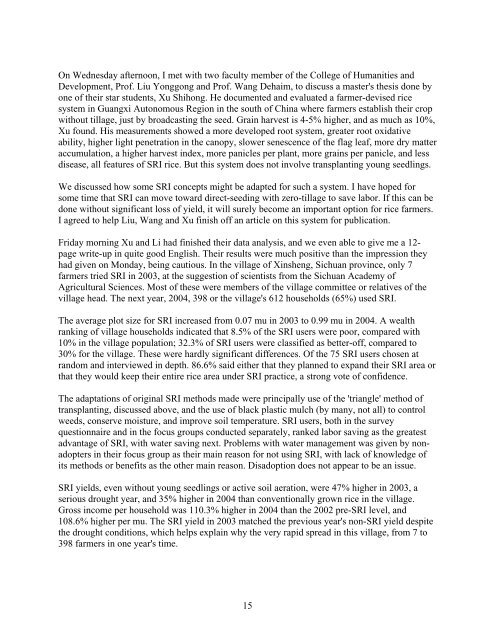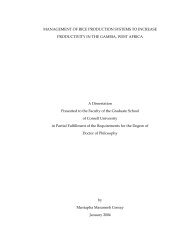Report from SRI China visit - The System of Rice Intensification ...
Report from SRI China visit - The System of Rice Intensification ...
Report from SRI China visit - The System of Rice Intensification ...
Create successful ePaper yourself
Turn your PDF publications into a flip-book with our unique Google optimized e-Paper software.
On Wednesday afternoon, I met with two faculty member <strong>of</strong> the College <strong>of</strong> Humanities and<br />
Development, Pr<strong>of</strong>. Liu Yonggong and Pr<strong>of</strong>. Wang Dehaim, to discuss a master's thesis done by<br />
one <strong>of</strong> their star students, Xu Shihong. He documented and evaluated a farmer-devised rice<br />
system in Guangxi Autonomous Region in the south <strong>of</strong> <strong>China</strong> where farmers establish their crop<br />
without tillage, just by broadcasting the seed. Grain harvest is 4-5% higher, and as much as 10%,<br />
Xu found. His measurements showed a more developed root system, greater root oxidative<br />
ability, higher light penetration in the canopy, slower senescence <strong>of</strong> the flag leaf, more dry matter<br />
accumulation, a higher harvest index, more panicles per plant, more grains per panicle, and less<br />
disease, all features <strong>of</strong> <strong>SRI</strong> rice. But this system does not involve transplanting young seedlings.<br />
We discussed how some <strong>SRI</strong> concepts might be adapted for such a system. I have hoped for<br />
some time that <strong>SRI</strong> can move toward direct-seeding with zero-tillage to save labor. If this can be<br />
done without significant loss <strong>of</strong> yield, it will surely become an important option for rice farmers.<br />
I agreed to help Liu, Wang and Xu finish <strong>of</strong>f an article on this system for publication.<br />
Friday morning Xu and Li had finished their data analysis, and we even able to give me a 12page<br />
write-up in quite good English. <strong>The</strong>ir results were much positive than the impression they<br />
had given on Monday, being cautious. In the village <strong>of</strong> Xinsheng, Sichuan province, only 7<br />
farmers tried <strong>SRI</strong> in 2003, at the suggestion <strong>of</strong> scientists <strong>from</strong> the Sichuan Academy <strong>of</strong><br />
Agricultural Sciences. Most <strong>of</strong> these were members <strong>of</strong> the village committee or relatives <strong>of</strong> the<br />
village head. <strong>The</strong> next year, 2004, 398 or the village's 612 households (65%) used <strong>SRI</strong>.<br />
<strong>The</strong> average plot size for <strong>SRI</strong> increased <strong>from</strong> 0.07 mu in 2003 to 0.99 mu in 2004. A wealth<br />
ranking <strong>of</strong> village households indicated that 8.5% <strong>of</strong> the <strong>SRI</strong> users were poor, compared with<br />
10% in the village population; 32.3% <strong>of</strong> <strong>SRI</strong> users were classified as better-<strong>of</strong>f, compared to<br />
30% for the village. <strong>The</strong>se were hardly significant differences. Of the 75 <strong>SRI</strong> users chosen at<br />
random and interviewed in depth. 86.6% said either that they planned to expand their <strong>SRI</strong> area or<br />
that they would keep their entire rice area under <strong>SRI</strong> practice, a strong vote <strong>of</strong> confidence.<br />
<strong>The</strong> adaptations <strong>of</strong> original <strong>SRI</strong> methods made were principally use <strong>of</strong> the 'triangle' method <strong>of</strong><br />
transplanting, discussed above, and the use <strong>of</strong> black plastic mulch (by many, not all) to control<br />
weeds, conserve moisture, and improve soil temperature. <strong>SRI</strong> users, both in the survey<br />
questionnaire and in the focus groups conducted separately, ranked labor saving as the greatest<br />
advantage <strong>of</strong> <strong>SRI</strong>, with water saving next. Problems with water management was given by nonadopters<br />
in their focus group as their main reason for not using <strong>SRI</strong>, with lack <strong>of</strong> knowledge <strong>of</strong><br />
its methods or benefits as the other main reason. Disadoption does not appear to be an issue.<br />
<strong>SRI</strong> yields, even without young seedlings or active soil aeration, were 47% higher in 2003, a<br />
serious drought year, and 35% higher in 2004 than conventionally grown rice in the village.<br />
Gross income per household was 110.3% higher in 2004 than the 2002 pre-<strong>SRI</strong> level, and<br />
108.6% higher per mu. <strong>The</strong> <strong>SRI</strong> yield in 2003 matched the previous year's non-<strong>SRI</strong> yield despite<br />
the drought conditions, which helps explain why the very rapid spread in this village, <strong>from</strong> 7 to<br />
398 farmers in one year's time.<br />
15
















